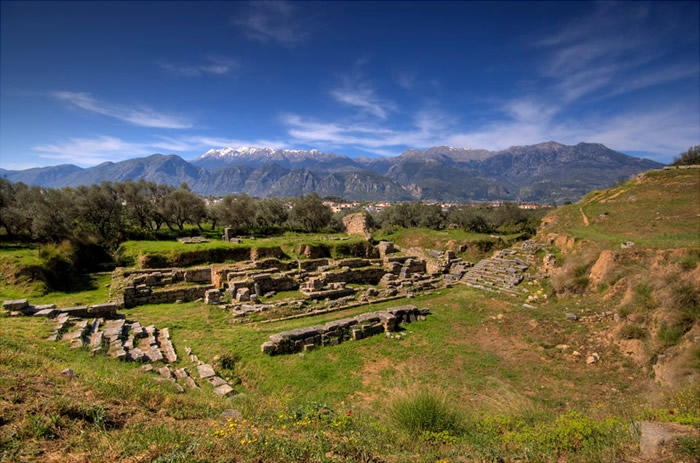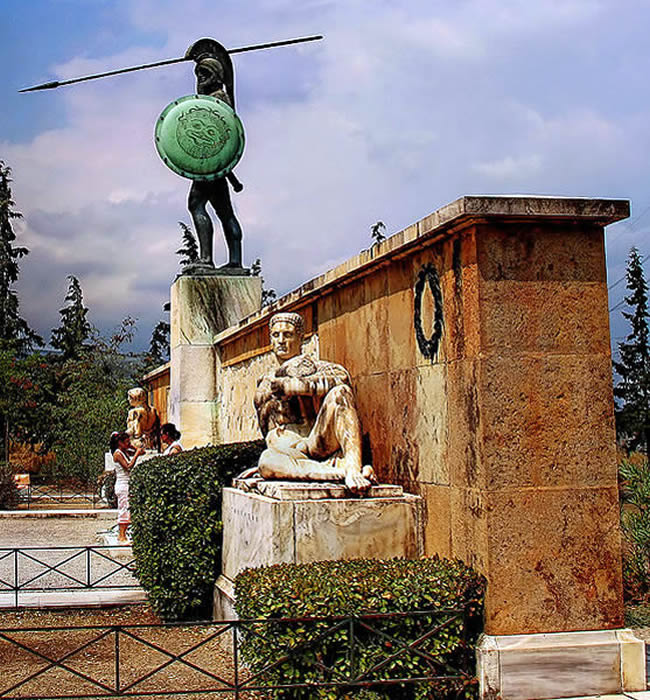 Spartan Kingdom
Spartan Kingdom

(Text by Duane R. Hurst © 2013)
Click on a link to view its information and pictures.
|
SPARTAN LINKS: Significant Event: Battle of Leuctra in 371 BC Leonidas I at Thermopylae Peloponnesian War Main Cities: Sparta Time: 900-192 BC Language: Greek Personage: Areus I; Leonidas I Religion: Greek Gods Related Country: Greece Brief History: I have included only a few items concerning the history of this kingdom. A good source for more details can be found on Wikipedia or in history books. |
|
|
EARLY YEARS:
Therapne was an ancient Mycenaean town that preceded Sparta. Greek historian Herodotus claimed Dorians from Macedon founded Sparta 60 years after the Trojan War. However, ruins show that Sparta only started 200 years after collapse of the Mycenaean civilization (circa 1000 BC). Four villages formed the original Spartan Polis. Lawgiver Lycurgus reportedly brought order to the early chaotic city-state. EXPANSION OF THE STATE: Sparta expanded by attacking Dorians from Argos and Achaean Greeks from Arcadia. Traditional kings, Archelaos and Charillos, seized city-states in the Eurotas Valley, including Geronthres and Pharis. Amykles was conquered circa 750 BC. In the late 8th century or early 7th century BC, King Theopompus conducted a war (743-724 BC) against Messenia but failed to conquer the region. Sparta eventually crushed a helot uprising in a second war (685-668 BC). Spartan society became more militarized and its hoplites were the most feared warriors of the time. WARS WITH PERSIA: From 499 to 493 BC, Ionian Cities revolted against the Persian Empire and received military support from Athens and Eretria in 498 BC. King Darius defeated their forces in the Battle of Ephesus and at other locations, quashed the revolt and mustered an army to punish the mainland Greeks. In 492 BC, Mardonius (son-in-law to Darius) reconquered Thrace and made Mecedon a client state. A storm near Mount Athos destroyed many of the Persian ships, which halted the campaign. Darius sent warning to the Greek city-states in 491 BC, but Athens and Sparta executed the ambassadors. A large naval force under admiral Datis and troops under Artaphemes succeeded in enslaving people from many Greek islands and razed Eretria. Although they landed in the bay of Marathon, Athenian and troops from Plataea soundly routed the Persians at the Battle of Marathon in August/September 490 BC. In 480 BC, Persian king Xerxes I personally led a large army and naval force against Greece. They crossed the Hellespont unopposed. Greeks originally planned to stop the Persians at the Vale of Tempe, but reconsidered that Thermopylae was better suited. The main Spartan army delayed due to a religious ceremony, but king Leonidas I led his personal guard of 300 men, who all died in the Battle of Thermopylae. Simultaneously, Greek naval forces defeated Persian ships in the Battle of Artemisium. These actions allowed Greek city-states to prepare a defense. Athenians abandoned their city for safety on Salamis Island. During the Battle of Salamis in 480 BC, the Persian admiral (Ariabignes) died and a combined Greek naval fleet defeated the forces of King Xerxes. Although Xerces departed for home, he left a powerful army behind, under the command of general Mardonius. In August 479 BC, a combined Greek force under Spartan command defeated and killed Mardonius in the Battle of Plataea. On the same day a Greek fleet under Spartan king Leotychides routed a Persian army of 60,000 men at Mount Mycale and destroyed their ships. EMPIRE AND PELOPONNESIAN WAR: (454-404 BC) In 431 BC, a three-phase war started between Athens and the Spartan-led Peloponnesian League. This ended in collapse of the Athenian Empire and Spartan conquest of Athens. Phase One: Archidamian War In 440 BC, Samos revolted against Athens and received immediate support from Persia. Sparta considered aiding the rebels, but Corinth vetoed the idea. Athens crushed the revolt and peace remained between the two Leagues. Conflict loomed after Athens aided the island of Corcyra against Corinth in the Battle of Sybota (433 BC). Athens also provoked Megara, a Spartan ally, with stringent trade sanctions. Corinth pressured Sparta, under King Archidamus II, to resist Athenian actions. Spartan land forces invaded Athenian territory but could not triumph over naval forces, and the populous found refuge within the Long Walls. Sparta lost battles at Pylos and Sphacteria in 425 BC. This phase ended in March 421 BC with a Peace of Nicias (aka Fifty-Year Peace). Phase Two: Sicilian Expedition In 415 BC, Athens sent a large expeditionary army and naval force to attack Syracuse in Sicily. Rationale was to support their Sicilian allies, who were Ionian people similar to those of Athens. Sparta and Syracuse were allied Dorians. Athens actually planned to use Sicily as a staging area for attacks on Carthage and Magna Graecia. Alcibiades led the ill-fated expedition, but defected to Spartans at Syracuse when enemies in Athens plotted for his arrest on false charges. General Nicias landed a force of 5,000 infantry but procrastinated his attack on Syracuse, which allowed Sparta to send aid. In 414 BC, general Gylippus defeated the Athenians in a series of battles. Nicias also lost a sea battle, failed to withdraw, and his entire force died or became slaves. Alcibiades returned to Athens and, surprisingly, led the military in regaining much of the empire's lost territory. Phase Three: Decelean or Ionian War Sparta, with support from Persia, undermined Athens by aiding rebellions in Ionia and the Aegean. In 406 BC, Spartan commander Lysander defeated an Athenian fleet at Notium (near Claros). Spartan forces also closed a crucial silver mine, freed 20,000 slaves and encouraged Ionian allies to abandon the Delian League. Lack of support from Sparta and its allies resulted in Athens quashing the rebellion. Athens defeated Spartan fleets at Cyzicus (410 BC) and Arginusae (406 BC). A foolish decision to censure triumphant Athenian commanders allowed Lysander to capture the source of Athens' grain, which resulted in starvation and Athenian surrender. He also defeated the Athenian fleet at Aegospotami in 405 BC. END OF SPARTA: Between 395 and 387 BC, Sparta became embroiled in the Corinthian War, battling forces from Argos, Athens, Corinth, Thebes and Persian support. Athens and Persia eliminated Sparta's naval power in the Battle of Cnidus (394 BC), but Persia withdrew support after Athen's recaptured previously held islands. A Peace of Antalcidas in 387 BC ceded Ionia to Persia and recognized independence of all other Greek city-states. In 371 BC, Sparta's full army suffered its first defeat at the Battle of Leuctra against Epaminondas of Thebes. Sparta never recovered from losses in the battle and subsequent revolts. Nevertheless, Sparta withstood attempted conquest from Philip II and Alexander. In 331 BC, Spartan king Agis III died in the Battle of Megalopolis, after Macedonian forces aided the city. Alexander compelled Sparta to join the League of Corinth. Rome forced Sparta into the Achaean League and conquered Sparta in 146 BC. |
|
|
© Page Publisher: Duane R. Hurst
|


